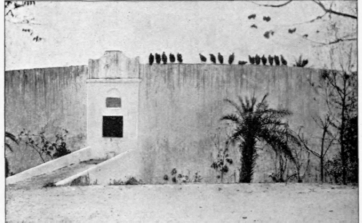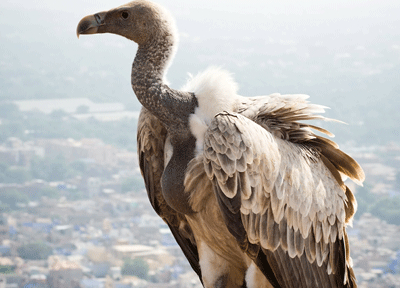Recently, in a discussion about green funeral options on the blog HTMLGiant, the topic of animals devouring the dead was brought up and I mentioned the Zoroastrian / Parsi tradition of 'sky burials' where remains are left for vultures to devour in 'towers of silence'. Though not for everyone by any means, this may well be one of the oldest and greenest of disposition options.
In the discussion, I noted that in modern times the vultures are disappearing, and I mistakenly blamed antibiotics in humans for the decline in the vulture population in India.
I decided to look into the subject further for the Daily Undertaker and found that in fact, the decline in the vulture population is due to drugs that are given to cattle (and may be banned already.) I also learned that efforts are underway to bring the vultures back. This is a positive step for Parsis, vultures, and for the ecosystem as well.
Yazd, Iran-Walking across the wind-whipped plains of the forgotten city, a young Iranian woman dressed in colorful floral garbs points out a sand-dusted tower hovering in the distance like a dormant volcano under a relentless sun. “This is where we put tens of thousands of corpses over the years,” she explains with a congenial smile.
The funerary tower is part of the ancient burial practice of Zoroastrianism, the world’s oldest monotheistic religion. Zoroastrians (known in India as Parsis) regard sky burials, in which the bodies are exposed to natural elements including vultures in open-topped “Towers of Silence,” as an ecologically friendly alternative to cremation, consistent with their religion’s reverence for the earth. A Zoroastrian priest clad in a long, cotton robe explains: “Death is considered to be the work of Angra Mainyu, the embodiment of all that is evil, whereas the earth and all that is beautiful is considered to be the pure work of God. We must not pollute the earth with our remains.”
The priest believes that open burials are a fulfillment of the central tenet of his religion, which is to practice good deeds. With a forlorn expression, he notes that, 3,000 years after the tradition of open burials began, there are not enough Zoroastrians left alive to keep the tower in Yazd open. Instead, today’s Zoroastrians who want to observe traditional burial practices must request in their will that their body is sent to a forested suburb in Mumbai, India, where the last Tower of Silence still operates. parsikhabar.net/the-last-of-the-zoroastrians/
But the Tower of Silence in Mumbai has had problems of its own:
Mumbai- The Parsi tradition of keeping bodies in the Tower of Silence to be devoured by vultures was under threat as birds of prey had gone almost extinct in Mumbai. Now, the Bombay Parsi Panchayet has decided to import and begin breeding vultures, on which Parsis rely to dispose of their dead. The project is being led by scientists at the Bombay Natural History Society, who have seen recent success in breeding the endangered birds in conservation centres in Haryana. Once governmental permissions have been obtained, about a 100 of the almost extinct scavengers will be brought into Mumbai at first and will be housed in three aviaries, two of which will be at the Towers of Silence. Leaders in the community and 98 per cent of all Parsis still opt for the traditional method of disposal – that is, consigning bodies to the Towers. So breeding vultures, they say, will not only ensure they are fulfilling their religious duty, but also helping ecological conservation. "It's a win-win situation for the community, maybe now, instead of 98 percent, 99 percent of Parsis will come back to this method of disposal," said Khojesti Mistry of World Alliance of Parsi and Irani Zarthoshtis (WAPIZ). ibnlive.in.com/news/parsis-to-import-breed-vultures/36199-3.html
Certainly the reintroduction of vultures does have a very real and positive impact on ecosystems in India. The vultures, although creepy to some, play a vital role. When vultures are missing from the ecosystem less desirable animals such as rats and packs of wild dogs move in to scavange. In addition to species diversity issues, these animals pose a threat to the health and safety of the human population.
Originally POSTED in the Daily Undertaker
www.dailyundertaker.com/2009/02/vulture-club-tower-of-silence.html

